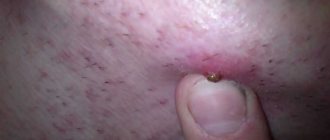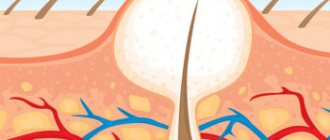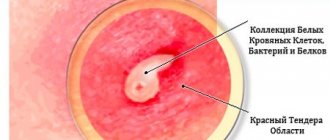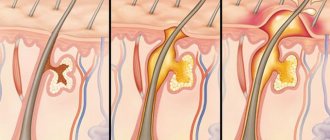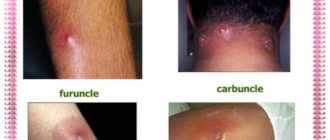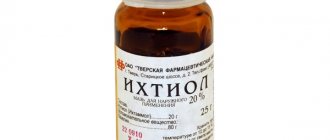What is the necrotic core of a boil, what does it look like and how to remove it so as not to spread the infection? How to remove the entire core of the boil? Is it possible to do this at home?
The complete process of boil formation takes approximately 10–14 days, taking into account the moment the bacteria enters the hair follicle. If a sufficiently dense and hard core has formed inside the boil, it means it is fully mature and it is the release of this core and purulent contents that indicates that the healing process of injured tissue has begun.
What is a boil on the neck?
A furuncle on the neck is an acute, painful inflammatory process in the hair follicle, which is connected to it by the sebaceous gland and adjacent tissue, which resembles red bumps in appearance.
The provoking factor of the disease is a strain of staphylococcus that penetrates the hair follicle when rubbed with clothing, injury or minor damage to the skin.
The boil is predominantly concentrated on the back of the neck, which is associated with regular friction against the collar of clothing. Inflammation is manifested by redness of the skin and swelling; touching the affected area causes discomfort.
On this topic
- Boil
How to recognize and treat a boil under the armpit
- Irina Nasredinovna Nachoeva
- August 19, 2021
The formation of a boil near the neck is very rapid. After 2-3 days, in the midst of suppuration, a green necrotic core appears visible through the skin. After another 2-3 days, the boil bursts and its internal contents are knocked out.
Pus is released for about 2 days and ends with the release of the rod itself. It is not recommended to puncture the abscess and squeeze out its contents or the core on your own, as the likelihood of tissue damage and deep infection increases.
Before the contents come out, patients often experience general weakness: increased body temperature, lethargy, etc.
The ulcerative funnel formed as a result of the exit of the rod begins to scar, and this ends the healing process of the boil. The period from the onset of inflammation to scarring lasts approximately 20 days. But with carbuncles (accumulations of multiple boils), recovery can be delayed.
Abscess and internal boils - what are they?
An exacerbation of the purulent-inflammatory process is an abscess boil. What is he? An abscess is a collection of pus that forms as a result of infection in the subcutaneous tissue.
A boil abscess is caused by the same pathogenic bacteria whose vital activity provoked the appearance of the boil itself. And the factors that contribute to this are:
- a sharp weakening of the immune system, when the body simply does not have the strength to resist negative external influences. A decrease in protective forces can be caused by chronic illnesses or severe overwork;
- insufficient personal hygiene, as a result of which not only boils are formed, but also their complications in the form of abscessed boils. Do not touch abscesses with unwashed hands, otherwise infection is almost guaranteed;
- ineffective and improper treatment of ulcers. An abscess is often provoked by attempts to remove it yourself by squeezing or puncturing. Often patients try to warm up the sore spot if the abscess does not break out on its own for a long time.
If the boil grows and hardens, and the core does not form in the prescribed time, then the patient should definitely visit a doctor. What other signs indicate abscess formation of a boil:
- a significant increase in body temperature, often up to 39-40°;
- weakness, sweating, fever;
- severe pain at the site of inflammation;
- headache.
In most cases, treatment of an abscess boil is performed surgically.
Chiryak can jump up not only on the surface of the skin. There are also subcutaneous formations - internal boils. They form deep inside the epidermis, affecting adipose tissue and the dermis layer.
The danger of internal boils is that purulent masses can break not outward, but inward, penetrating into the vessels and lymph. And this is fraught with thrombophlebitis, lymphadenitis, sepsis, meningitis .
One of the signs of internal boils is that the necrotic core takes too long to form. Sometimes an abscess forms without a head. This complicates treatment and delays the recovery process.
Causes
The appearance of a boil near the neck is provoked by many circumstances. Harmful staphylococcus, entering the hair follicle, can cause inflammation inside it and in the adjacent sebaceous gland. Infection occurs for a number of reasons, which can be external or internal.
External factors include the following:
- dirty skin and irregular care for it;
- intense sweating, greasy skin;
- traumatism ;
- overheating or hypothermia.
On this topic
- Boil
Let's find out how to treat a boil on the eye
- Irina Nasredinovna Nachoeva
- August 19, 2021
A boil on the neck can be caused by internal factors:
- disorders ;
- diabetes ;
- excess weight ;
- prolonged stressful situations and psycho-emotional stress;
- weakened immune system.
An unbalanced diet and disorders in the functioning of the gastrointestinal tract also affect the formation of boils.
If you shave inaccurately, minor injuries may remain on the skin, through which staphylococcus easily penetrates under it.
Due to the above factors, a recurrent course of the disease occurs, the appearance of multiple suppurations (carbuncles).
Signs of correct removal of the boil stem
If you have encountered this pathology for the first time, you need to know how to remove the core of the boil and what should be left after it. To understand that all actions were correct, you should pay attention to the following signs:
- the swelling around the wound gradually subsides;
- a purulent root came out;
- no compaction is felt during palpation;
- after removing all the contents of the boil, a reddish liquid with small admixtures of blood should be released from the wound;
- after a few days the swelling decreases and the pain disappears almost completely.
After such a procedure for removing the core of the boil, an ugly scar may remain in its place. If the inflammation is localized in the groin area, neck or face, you should stop doing it yourself and seek help from a doctor, which will help avoid negative consequences.
Symptoms
The formation of boils on the neck occurs in stages. The following stages of abscess formation are distinguished:
- red spot appears on the neck There is no physical discomfort.
- Several days will pass and the boil will begin to develop. There will be tingling, burning, and twitching. A white top will become noticeable inside the suppuration.
- After several days, the boil will open and the pus will come out. This will leave a slight deep wound that will heal. Usually small suppurations do not leave scars.
It is forbidden to break through a boil on your neck yourself. There is a high risk of adverse consequences in the form of tissue damage. This may lead to subsequent infection.
What does the core of a boil look like - photo
At the second stage of inflammation, a purulent-necrotic root or core of the boil begins to form. After this stage is completed, a white abscess becomes noticeable on the surface of the boil, slightly rising above the surface of the skin. There is inflamed red skin around it.
The course of development of the boil includes the thickening of necrotic masses until the formation of a dense cylinder, which is located under the lid of the abscess. The walls gradually thicken, resulting in a protective membrane forming around the purulent infiltrate, preventing the spread of infection to healthy areas of the skin.
The photo shows the core of the boil
As a result of the influence of leukocytes, a dense cylinder is formed from pus, which is pushed out. Then the healing stage begins. The purulent contents, which are located deep in the formation and look like a dense column of yellow-green color, are the core. Now you know what the core of a boil looks like and how to determine its complete removal.
The core of the boil is an accumulation of not only inflammatory cells, but also the secretion of the sebaceous gland, including the epithelium, which was destroyed during the inflammatory reaction. Also inside the rod there is a large number of harmful bacteria that provoked the formation of a boil.
Diagnostics
If signs of an inflammatory process of the skin are detected, the patient should visit a dermatologist. The specialist will be able to accurately make a diagnosis based on the results of an external examination and dermatoscopy of the damaged area.
To determine the origin of the virus, bacterial culture of the discharged boil is carried out. Recurrent and multiple neoplasms will be an indication for a general diagnosis of the patient with a laboratory test of blood and urine, a blood test for sugar, urine culture, and rhino- and pharyngoscopy, X-ray, fluorography, and ultrasound.
If the need arises, a person can additionally be advised by specialized doctors. The formation of adverse consequences requires blood cultures for sterility, computed tomography, magnetic resonance imaging, and lumbar puncture.
A boil on the neck should be distinguished from hidradenitis, folliculitis, granuloma, anthrax, skin tuberculosis and other skin diseases.
Possible complications
Unfortunately, many people do not pay due attention to the treatment of the wound cavity, since the pain goes away and the boil no longer bothers them. Meanwhile, repeated infection can trigger the development of other boils throughout the back and beyond. This condition is called furunculosis, and it will be much more difficult to cope with than with a single abscess.
When infection enters the wound, furunculosis may develop.
Even greater complications can arise if the patient tries to open the abscess on his own before it has fully matured:
- development of abscesses in the subcutaneous layer;
- spread of boils to other parts of the body, chronic furunculosis;
- blockage of blood vessels in the area of suppuration;
- blood poisoning;
- when boils are localized in the lumbar area, the inflammatory process can spread to the kidneys;
- purulent meningitis and sepsis.
But even in the absence of complications, unpleasant consequences of boils remain in the form of small white scars on the skin. They are especially clearly visible on tanned skin, which significantly spoils the appearance.
Treatment
Due to the close location of the boil to the brain and severe pain, it is recommended to visit a specialist at the initial symptoms and select the optimal methods of therapy. At the initial stage of boil formation, a specialist prescribes ultraviolet and electromagnetic irradiation.
Such therapy helps get rid of infectious lesions and prevents the formation of suppuration. If pus is already accumulating, the doctor will prescribe a special drawing ointment, which accelerates the maturation of the boil on the neck and the release of the pus itself.
Antibiotics are used in combination with such medications to reduce the likelihood of infection spreading into the body.
Home therapy includes several methods.
Wet warm compress
It is one of the most effective ways to counteract boils. It is necessary to wet the napkin with water, heat it and apply it with a heating pad to the damaged area on the neck. This helps relieve pain and improve blood flow in that area.
With improved blood circulation, the number of infection-fighting white blood cells increases. Sometimes immersing yourself in a seawater bath can be effective.
Turmeric
It is an antibiotic of natural origin that can relieve inflammation and normalize the functioning of the digestive organs. It is taken orally: 1 tsp. spices and water are washed down with 0.5 liters of water.
Take three times a day. This plant leads to dehydration and constipation, so you should drink plenty of fluids and saturate your diet with foods that are rich in fiber.
Pulling ointments
They accelerate the process of formation of the head of the boil, and also contribute to their opening and the release of suppuration. The following are suitable for this: Vishnevsky ointment, Ichthyol ointment or Levomekol.
It is possible to make the product yourself. It is necessary to melt the butter and add beeswax in a ratio of 4 to 1. The mixture is thoroughly heated, but not boiled, and applied to the boil for 2 days without removing the compress.
Drug therapy to remove the core of the boil
Of the wide range of pharmaceutical drugs for the treatment of boils, the most popular are ichthyol ointment and Vishnevsky ointment. Also beneficial are products based on streptocide and syntomycin.
These compositions help to quickly relieve the symptoms of inflammation, reduce the painful syndrome, and accelerate the release of pus. In the most severe cases, when there is a high probability of infection spreading, antibiotics are prescribed.
Ointments are used in the form of a compress:
- Apply a small amount of product to a clean cotton pad;
- the disc is applied to the abscess;
- fixed with a bactericidal patch or sterile bandage;
- every 2–3 hours the bandage is changed and a new compress is applied.
If the boil has opened
If the boil bursts and its contents come out, and the inflammatory processes in the tissues near the hole do not go away, you must immediately contact a specialist. In such a situation, the need for surgical intervention arises.
The necrotic core is removed and the contents are cleaned. The procedure is performed under local anesthesia. After removing a boil on the neck, the wound is lubricated with Vishnevsky ointment for several days to speed up recovery.
Surgical intervention is necessary only in situations where there is deep tissue damage and the boil cannot open on its own.
On this topic
- Boil
What threatens a boil inside the nose?
- Irina Nasredinovna Nachoeva
- August 19, 2021
When the formation has opened, the wound should be treated with hydrogen peroxide and covered with a sterile gauze bandage. It is forbidden to press or scratch the boil.
When treating boils, in some cases broad-spectrum antibiotics (Ampicillin, Ampiox) are used. This therapeutic technique quickly eliminates the disease and eliminates the inflammatory process.
When there are a lot of boils, complex treatment is used: a complex of vitamins and immunomodulators are added to the use of medications.
Removal of the boil core by surgical intervention
At first, this disease can be confused with a simple pimple, but soon the boil begins to grow and severe pain appears. The patient turns to the doctor. In the first stages, the doctor only monitors the development of the disease and prescribes remedies for external and internal treatment.
In the most severe cases, when the core of the boil does not come out on its own, an operation is prescribed, during which the abscess is opened and its contents are completely removed.
The rehabilitation period is most important, because the outcome of the treatment depends on compliance with the doctor’s recommendations. Periodically, the wound should be treated with products prescribed by the doctor. Regular dressing changes are mandatory.
Why is it dangerous?
The neck is one of the most dangerous areas for furunculosis to manifest itself. Here are the blood vessels that supply blood to the brain.
When pus penetrates inside them, adverse consequences can occur - purulent meningitis. Directly because of this, mechanical impact on boils is prohibited.
In the process of penetration of suppuration into the bloodstream, the infection can spread throughout the body and metastasis will appear on the internal organs.
The emerging complication tends to develop quickly, and the patient’s well-being deteriorates sharply. Symptoms of general poisoning occur, body temperature increases, chills may alternate with fever. If treatment is not timely, complications that develop can lead to death.
Characteristic manifestations
The first sign of a boil is a barely noticeable swelling and redness on the skin of the back around the hair. On the first day it can be mistaken for a regular pimple, but over the next two to three days other symptoms appear, clearly indicating a purulent abscess. In general, the period of formation and ripening of a boil takes from a week to 10 days, relief occurs immediately after the purulent contents come to the surface. The whole process is conventionally divided into three stages, each of which has its own manifestations.
Table. Stages of boil development
| Stage | Typical manifestations |
| Infiltration | The skin at the site of infection thickens, turns red, and swelling is observed around the hair. Pain occurs, which intensifies significantly as the abscess develops. Often this condition is accompanied by an increase in temperature. |
| A purulent core forms inside the swelling, which looks like a small whitish spot in the center of the boil. This spot gradually enlarges, accompanied by increased pain, until the purulent cavity opens. With the release of pus, the pain completely subsides. |
| After the purulent mass comes out, a wound with a deep hole remains, which is gradually covered with connective tissue. When the healing process is complete, a mark remains on the skin in the form of a dense white scar several millimeters long. |
It should be noted that an open wound is easily infected, so until complete healing it is necessary to carry out antiseptic treatment of the affected area as thoroughly as possible.
Prevention
To prevent the formation of boils on the neck, the following instructions must be observed:
- adhere to hygiene rules ;
- harden the body;
- strengthen the immune system;
- disinfect minor damage to the skin;
- do not wear clothes with narrow collars.
A balanced diet is important in preventing the disease. A nutritious diet rich in vitamins and minerals prevents obesity and helps strengthen the immune system.
If you suspect a boil, you should immediately consult a specialist and begin treatment for the inflammatory process.
A boil on the neck is an extremely common purulent inflammatory disease. Under the influence of staphylococcus that has penetrated into the hair follicle, suppuration is formed, which affects the follicle itself and nearby tissues.
Due to its close location to the brain, a boil on the neck is very dangerous, as it can cause meningitis. Therefore, it is extremely important to consult a doctor in a timely manner and begin treatment.
Traditional recipes for the treatment of furunculosis in the early stages
There are three stages: the initial stage, called the infiltration stage, necrosis, and the healing stage. The way a boil looks in the photo is directly determined by the stage.
If it is not possible to visit a doctor, you can try to reduce pain and swelling during inflammation using traditional recipes. Also, folk remedies help speed up the ripening of the rod and remove pus from the wound.
Freshly squeezed onion and garlic juice helps localize inflammation, accelerate the maturation of the stem and the removal of pus. To treat a boil, it is recommended to lubricate the affected area of skin with freshly squeezed onion or garlic juice several times a day.
Freshly squeezed onion and garlic juice
If inflammation has formed on the thighs or buttocks, then you can use the following recipe: mix honey and flour until a thick mass is formed. Apply the resulting cake to the inflamed formation. Honey is a natural antiseptic and helps remove pus from the wound.
Honey and flour
Aloe has antiseptic and antimicrobial effects. To reduce inflammation and provoke the outflow of pus, it is recommended to apply the crushed plant to the boil.
Treatment of aloe boil
Coltsfoot has wound-healing and anti-inflammatory effects, so crushed fresh leaves are an effective remedy for reducing inflammation and quickly healing the skin. It is recommended to use this plant after the rod comes out of the wound.
Plant Coltsfoot
Important information! It is worth remembering that any self-medication can be not only useless, but also dangerous to health.

